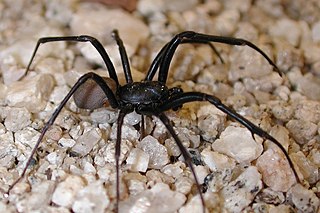
Titanoecidae is a family of araneomorph spiders first described by Pekka T. Lehtinen in 1967. It is fairly widespread in the New World and Eurasia with five genera and more than 50 species worldwide. These are mostly dark-colored builders of "woolly" (cribellate) silk webs. Several species are found at relatively high altitudes in mountain ranges and may be very common in such habitats.

Carrhotus is a genus of jumping spiders that was first described by Tamerlan Thorell in 1891. The name is derived from the Greek Κάῤῥωτος.
Hisukattus is a genus of the spider family Salticidae.
Mopiopia is a genus of jumping spiders that was first described by Eugène Louis Simon in 1902.

Titanoeca is a genus of spiders that occurs mainly in Eurasia, with three species found only in North America. One species has a holarctic distribution, and T. guayaquilensis is endemic to Ecuador.
Goeldia obscura is a spider species from Colombia and Peru. It is not to be confused with Titanoeca quadriguttata from Europe; both shared the name Titanoeca obscura, but at different times. While G. obscura was never cited as T. obscura since its original description in 1878, T. quadriguttata was cited as T. obscura in various papers from 1932 to 1993, and can be found under this name in later, non-scientific works.

Titanoeca quadriguttata is a species of spider in the family Titanoecidae. It is widespread in Europe, though absent from Great Britain, and is found in Austria, Belgium, Bulgaria, Corsica, Croatia, Czech Republic, France, Germany, Greece, Hungary, Italy, Liechtenstein, Moldova, Russia, Slovakia, Spain, Switzerland, the Netherlands, Ukraine.

Titanoeca nivalis is a species of araneomorph spider in the family Titanoecidae. It has a Holarctic distribution.

Plectreuridae, also called plectreurid spiders, is a small spider family confined to the Southwestern United States, Mexico, and the Caribbean. Only two living genera are known—the nominate genus Plectreurys and Kibramoa. In the past, the family was more widespread, with the Jurassic genus Eoplectreurys known from China, the Eocene Palaeoplectreurys baltica from Baltic amber and the Miocene Plectreurys pittfieldi from Dominican amber.
Plectreurys tristis is a species of venomous spiders commonly known as primitive hunting spiders belonging to a family of plectreurid spiders. They produce a venom that contains a group of insecticidal peptides called plectoxins. They are found in western North America, Central America and Mexico.
Titanoeca spominima is a spider species found in Poland.

Cnephalocotes is a genus of dwarf spiders that was first described by Eugène Louis Simon in 1884. As of May 2019 it contains only three species: C. obscurus, C. simpliciceps, and C. tristis.
Heliophanus tristis is a jumping spider species in the genus Heliophanus. It was first described by Wanda Wesołowska in 2003 and lives in Ethiopia.
Eulonchus tristis is a species of small-headed flies in the family Acroceridae.

Titanoeca nigrella is a species of true spider in the family Titanoecidae. It is found in North America.
Titanoeca brunnea is a species of true spider in the family Titanoecidae. It is found in the United States and Canada.

Titanoeca americana is a species of true spider in the family Titanoecidae. It is found in North America.







